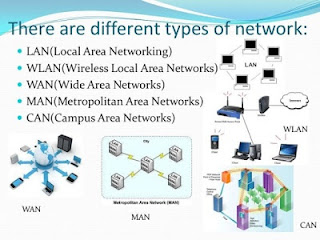A network is a group of
computers to share information, resources and exchange files. In computer
network each computer is called a node. A computer, printers or any other
devices connected in a network is also called a node.
Types of Computer Network:
1. LAN
2. MAN
3. WAN
4. PAN
1. LAN:
LAN stands for Local
Area Network. It is used for small area like a office, single building etc.
2. MAN:
It stands for Metropolitan
Area Network.This network is used for connect two cities. It is larger than
LAN.
3. WAN:
It stands for Wide
Area Network. This network is used for wide area. It is used to connect
different countries.
4. PAN:
It stands for
Personal Area Network. It is used for small area like a single room or house.In
this network we can connect our laptop with our mobile via hotspot or
Bluetooth.
1. Data and
Information sharing: In a computer network, computer can access
information that stored on the other computers in a network. For example, in a
university students database is stored on a server. An authorized person can
access this data by connecting to the network.
2. Hardware: In
network environment, every computer in a network can use hardware that is
providing for each user. For example, if we connect our personal computer and
printer to network then other user can access our printer over the network.
3. Software
Sharing: Recently used software is stored on the hard disk of server
so that other users on the network can access the software.
4. Communication: By
using network people can communicate efficiently and easily. It is a time and
cost saving way to communicate with each other.
Distributed System:Distributed system
consist of multiple computers that communicate via computer network. In
computer network, computer interacts with each other to achieve a common goal.
Advantages of
distributed system:
1. Modularity
2. Local
control of local data
3. Better
response time
4. Ability
to share data
5. Direct
user interaction
6. Greater
reliability
Network Criteria:
1. Performance: The
performance of a network can be measured in different ways, including response
time, number of users, transmission medium and hardware.
2. Reliability: Reliability
of network can be measured by frequency of failure, the time it takes a link to
recover failure.
3. Security: Network
security means protecting data from unauthorized access by unknown person.
Network Applications:
1.Electronic
Mail: E-mail or electronic mail is used for sending and receiving
mails. Email allows a person or group of persons to communicate via internet.
It is simple and easy way to communicate.
2.Video
Conferencing: It is a face-to-face communication system. Two persons
at different places can communicate with each other using video conferencing
using a network.
3.Electronic
Data Interchange: EDI means transmission of information between
companies. It is used to send document electronically from one computer to
another computer.
4.Electronic
Funds Transfer: EFT is used to fund transfer electronically. It is a
safe and secure fund transfer.
5. Facsimile: It
is also known as FAX. It is used to send a document.
Advantages of
Networks:
1. Resource
Sharing: The main aim of network is to make all data available to
everyone on the network.
2. High
Reliability: Computer network goal is to provide reliability. It
provides safe and secure transactions.
3. Saving Money: It
saves our money. Using network we can communicate with each other at different
places. We can send a message to other person within a second.
4. Scalability: The
network has the ability to increase the performance.
5. Communication
Medium: It provides a powerful communication medium among users.
6. Increased
productivity: It increase productivity as many people can enter data
at the same time from different places.
Some other links:


No comments:
Post a Comment